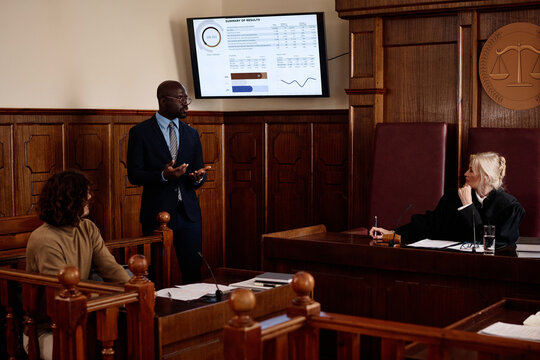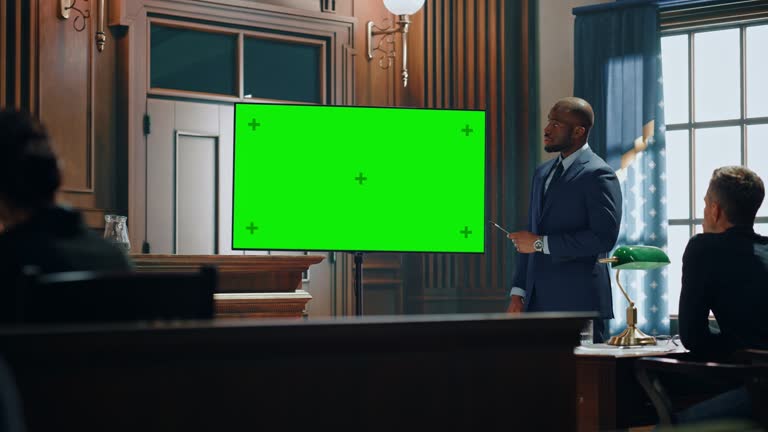Navigating the Intricacies of Test Presentations: Tips for Seamless Distribution and Compelling Arguments
In the world of lawful process, the art of trial presentation stands as an important component of success. The intricacies fundamental in trial discussions call for a fragile equilibrium of ability, strategy, and finesse.

Understanding Trial Goals
To properly navigate a trial, it is vital to have a clear understanding of the purposes that need to be achieved. Before entering the court room, legal teams need to specify their objectives and desired outcomes. These objectives serve as guiding principles throughout the trial, shaping methods and affecting decision-making procedures.
Recognizing test purposes entails a comprehensive analysis of the case, legal precedents, and the client's finest rate of interests. Trial Presentations. It needs a precise evaluation of the realities, recognizing crucial issues, and anticipating possible difficulties. By setting measurable and particular objectives, attorneys can tailor their arguments and presentations to line up with the preferred outcomes
Moreover, a clear grip of trial goals allows legal groups to focus on proof, witnesses, and lawful disagreements successfully. It enables the development of a coherent story that reverberates with the discretionary, reinforcing the general situation presentation.

Organizing Proof Successfully
Having a clear understanding of test goals lays the foundation for organizing proof successfully in legal proceedings - Trial Presentations. By aligning the presentation of proof with the preferred results of the trial, lawful groups can enhance their arguments and enhance their persuasiveness. One critical facet of organizing evidence is classification. Organizing evidence based on motifs or significance to particular legal components can assist improve the discussion and make intricate info more absorbable for the judge or jury.
One more crucial element in organizing proof successfully is establishing a rational flow. Offering evidence in a consecutive and systematic fashion can help construct a compelling story that supports the legal debates being made. Furthermore, making use of visual help such as charts, timelines, or charts can further improve the organization of proof and aid in making clear complicated relationships or series of occasions.
Moreover, ensuring that all evidence offered is pertinent and permissible to the situation is necessary. Pointless or inadmissible evidence can diminish the strength of the argument and potentially damage the credibility of the here and now party. A careful testimonial and option procedure need to be undertaken to include only the most impactful and legally sound evidence in the trial discussion.
Crafting Influential Stories
Crafting engaging stories plays a pivotal role in providing convincing debates throughout lawful proceedings. A well-crafted narrative has the power to astound the target market, evoke emotions, and ultimately sway the decision get redirected here for the providing celebration. When creating a story for a test discussion, it is vital to develop a clear story that highlights vital points and connects them in a meaningful way. Begin by detailing the truths of the situation in a compelling way, making sure that the sequence of events is easy to follow. Introduce personalities properly, giving history details that other assists the audience understand their motivations and activities. Furthermore, integrating vibrant descriptions and interesting language can bring the story to life, making it a lot more unforgettable for the discretionary. By weaving with each other proof, statement, and legal arguments right into a persuasive and natural story, legal professionals can effectively support for their clients and raise the chance of a positive result in the courtroom.
Understanding Visual Aids
Reliable use aesthetic help is essential to boosting the impact and clearness of test discussions. Visual help, when made use of strategically, have the power to streamline intricate information, enhance bottom lines, and leave a lasting perception on the court and court. To master visual help in test discussions, it is important to make certain that they are clear, succinct, and relevant to the disagreements being made.
When integrating aesthetic help, such as charts, charts, pictures, or timelines, right into a test discussion, it is necessary to maintain them aesthetically appealing yet specialist. The visuals should complement the verbal arguments, offering a visual representation of the info being gone over without frustrating the target market with unneeded information.
Additionally, exercising with the visual help ahead of time is critical to ensure a smooth distribution throughout the test. Acquainting oneself with the material, shifts, and timings of each visual aid can help maintain the circulation of the discussion and prevent technological problems that might develop.
Providing Impactful Closing Disagreements
A compelling closing argument offers as the culmination of a test presentation, enveloping the core narrative and persuading the court and jury in the direction of a favorable choice. Begin by outlining the major arguments that sustain your client's placement, emphasizing why the proof presented throughout the test supports your story.
Moreover, integrating psychological charm can further enhance your closing debate. By humanizing the case and check that attaching on a personal degree with the decision-makers, you can stimulate compassion and understanding, influencing their assumption of the realities offered. Additionally, repeating the legal requirements that must be fulfilled for a positive judgment can strengthen the legitimacy of your placement. Ultimately, a well-crafted closing disagreement need to leave a lasting perception, engaging the discretionary to rule in your client's favor.
Conclusion
In final thought, grasping trial presentations includes comprehending goals, arranging proof, crafting stories, using aesthetic help, and providing impactful closing disagreements. By carrying out these methods properly, legal representatives can offer their instance effortlessly and make engaging disagreements in the court. It is vital to browse the complexities of trial presentations with precision and ability to attain success in lawful procedures.
By aligning the presentation of proof with the wanted results of the test, legal teams can strengthen their debates and boost their persuasiveness (Trial Presentations). To grasp visual aids in test discussions, it is important to guarantee that they are clear, concise, and pertinent to the debates being made
An engaging closing disagreement serves as the end result of a trial presentation, enveloping the core story and convincing the judge and court towards a favorable choice. Begin by laying out the primary debates that support your customer's placement, highlighting why the evidence offered throughout the trial sustains your narrative.In conclusion, understanding test discussions involves recognizing goals, organizing proof, crafting narratives, making use of visual help, and delivering impactful closing debates.